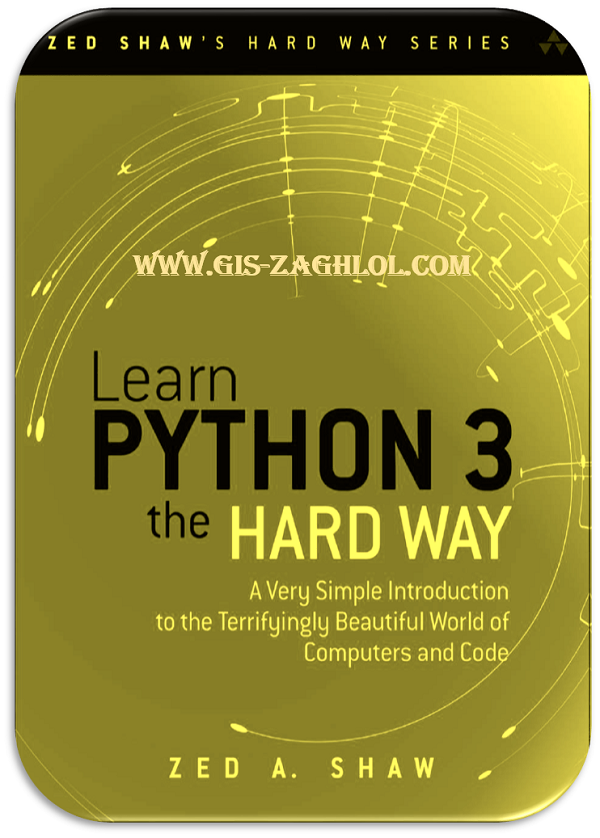تحميل كتاب تعلم بايثون 3 بالطريقة الصعبة Book Learn Python 3 The Hard Way pdf
تحميل كتاب تعلم بايثون 3 بالطريقة الصعبة Book Learn Python 3 The Hard Way pdf ، استكمالا لسلسلة تعلم بايثون Learn Python نقدم لكم في هذه المقالة كتاب تعلم بايثون 3 بالطريقة الصعبة Book Learn Python 3 The Hard Way pdf ، من تأليف Zed A. Shaw .
Introduction the book Learn Python 3 The Hard Way pdf
The Setup
This exercise has no code. It is simply the exercise you complete to get your computer to run Python. You should follow these instructions as exactly as possible. If you have problems following the written instructions, then watch the included videos for your platform.
A Good First Program
You should have spent a good amount of time in Exercise 0 learning how to install a text editor, run the text editor, run the Terminal, and work with both of them. If you haven’t done that, then do not go on. You will not have a good time. This is the only time I’ll start an exercise with a warning that you should not skip or get ahead of yourself.
Comments and Pound Characters
Comments are very important in your programs. They are used to tell you what something does in English, and they are used to disable parts of your program if you need to remove them temporarily.
Numbers and Math
Every programming language has some kind of way of doing numbers and math. Do not worry: programmers frequently lie about being math geniuses when they really aren’t. If they were math geniuses, they would be doing math, not writing buggy web frameworks so they can drive race cars.
Variables and Names
Now you can print things with print and you can do math. The next step is to learn about variables. In programming, a variable is nothing more than a name for something, similar to how my name, “Zed,” is a name for “the human who wrote this book.” Programmers use these variable names to make their code read more like English and because they have lousy memories. If they didn’t use good names for things in their software, they’d get lost when they tried to read their code again.
Your First Website
These final three exercises will be very hard and you should take your time with them. In this first one you’ll build a simple web version of one of your games. Before you attempt this exercise you must have completed Exercise 46 successfully and have a working pip installed such that you can install packages and know how to make a skeleton project directory. If you don’t remember how to do this, go back to Exercise 46 and do it all over again.
- Installing flask
Before creating your first web application, you’ll first need to install the “web framework” called flask. The term “framework” generally means “some package that makes it easier for me to do something.” In the world of web applications, people create “web frameworks” to compensate for the difficult problems they’ve encountered when making their own sites. They share these common solutions in the form of a package you can download to bootstrap your own projects.
Getting Input from a Browser
While it’s exciting to see the browser display “Hello World,” it’s even more exciting to let the user submit text to your application from a form. In this exercise we’ll improve our starter web application by using forms and storing information about users into their “sessions.”
- How the Web Works
Time for some boring stuff. You need to understand a bit more about how the web works before you can make a form. This description isn’t complete, but it’s accurate and will help you figure out what might be going wrong with your application. Also, creating forms will be easier if you know what they do.
The Start of Your Web Game
We’re coming to the end of the book, and in this exercise I’m going to really challenge you. When you’re done, you’ll be a reasonably competent Python beginner. You’ll still need to go through a few more books and write a couple more projects, but you’ll have the skills to complete them. The only obstacles will be time, motivation, and resources. In this exercise, we won’t make a complete game, but instead we’ll make an “engine” that can run the game from Exercise 47 in the browser. This will involve refactoring Exercise 43, mixing in the structure from Exercise 47, adding automated tests, and finally creating a web engine that can run the games. This exercise will be huge, and I predict you could spend anywhere from a week to months on it before moving on. It’s best to attack it in little chunks and do a bit a night, taking your time to make everything work before moving on.
- Refactoring the Exercise 43 Game
You’ve been altering the gothonweb project for two exercises, and you’ll do it one more time in this exercise. The skill you’re learning is called “refactoring,” or as I like to call it, “fixing stuff.” Refactoring is a term programmers use to describe the process of taking old code and changing it to have new features or just to clean it up. You’ve been doing this without even knowing it, as it’s second nature to building software. What you’ll do in this part is take the ideas from Exercise 47 of a testable “map” of Rooms and the game from Exercise 43 and combine them together to create.


تعليقات: 0
إرسال تعليق